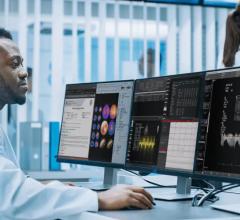
GE Healthcares Centricity Cardiology is a three-tiered solution that provides immediate access to all patient data.
Cardiovascular care does not occur in a single hospital setting; more often than not patients undergo a variety of tests at different locations. In order to provide the best care possible, physicians need immediate access to all patient information, no matter where, when or how it was obtained.
In response, many radiology PACS vendors have grown their platforms, some through mergers or acquisitions of cardiology PACS or CVIS providers, in an attempt to move from departmental solutions to enterprise-wide solutions. Enterprise-wide solutions tie together data and images from multiple modalities, departments and systems in an effort to break down silos that can inhibit efficiency and patient care. However, there is still much room for improvement toward a truly seamless, integrated cardiovascular system, says Nadim Daher, Frost & Sullivan industry analyst.
The challenge
From an imaging-only perspective, there are management solutions that work well for every modality. But a truly integrated system needs to be more than a cardiology PACS; it needs to cover the full range of functionality — appropriate and special reporting modules for each modality and each sub-procedure, as well as CVIS capabilities across every modality — and have it all on one platform. That is not the reality of the market today, Daher says.
James K. Min, M.D., a cardiologist with NewYork-Presbyterian Hospital, agrees that we still have a long way to go.
First of all, there is the need to combine different modalities on the same workstations, and do it well, he explained.
“Generally, for example, nuclear stress testing is still read on one platform, CT studies are read on another and MRI are read on yet another. In some cases, there is some overlap onto one workstation, but they certainly aren’t fully combined yet,” Dr. Min said.
“By consolidating image management for several modalities on a single platform, multimodality solutions can aid the formation of a single integrated view of a patient’s cardiovascular condition and enable the use of advanced workstations that support the new standards of cardiovascular care. Additionally, cardiology IT systems have to show further integration and interoperability to consolidate images from various sources and other enterprise systems,” Daher stated in a July 2008 Frost & Sullivan report.
While these goals are common, vendors are taking individual approaches, and the results are varied.
Physicians want to be able to sit down at one computer and have it all — image analysis, access to nonimage patient information and reporting functionality, says Dr. Min.
“Right now the reporting systems out there are pretty poor. And once you report, you want all that information to link to the EMR, and that is another big area for improvement,” he said.
What’s the biggest obstacle?
“There are too many little pieces to the puzzle,” believes Dr. Min. “Simplicity is good — right now there is too much complexity. The technology is there, but system organization needs to catch up.”
In the meantime, NewYork-Presbyterian uses a Web-based reporting system and thin-client applications that allow physicians to read from anywhere in the world, a big timesaver, says Dr. Min. They also use the GE Centricity PACS and workstation. The Centricity aims to incorporate reporting, EMR and image analysis all into one system, heading in what Dr. Min believes is the right direction.
Another company moving in the right direction, according to Stephen Cameron, administrator for The Cardiac and Vascular Center, St. Peter’s Hospital, Albany, NY, is Lumedx. St. Peter’s experience with the company dates back to 1992 when the hospital commissioned them for results reporting, essentially providing the hospital with an electronic repository for medical records.
More recently, the hospital needed all their different vendor rooms integrated into one PACS and into their reporting system, and Lumedx was able to tailor a solution to meet their needs. In addition, an essential component of the hospital’s long-term vision was to link to other physician offices — they felt the electronic medical record was crucial to the future.
“Lumedx are interface specialists,” said Cameron. “We’ve been able to produce, through the hospital information system and Lumedx CardioPACS, a wholly integrated medical record system. With a single sign-on and a single patient name, our physicians can not only get all the medical records information, discharge summaries, labs, etc., but they can also click on the cardiology component to access all the cardiology tests done in our facility in written form, and also pick up echo and cath images.”
St. Peter’s has also gained a lot of efficiencies through Lumedx’s CardioDoc reporting system, says Cameron. After the completion of a cath or echo, the system automatically prepares the report, the physician can electronically sign it, and it is sent to medical records and the attending physician. The report can also imbed itself into individual physicians’ medical records.
Given the current amount of systems available and their varying degrees of features and integration, end-users must thoroughly evaluate their needs/wants when seeking a solution. For facilities reluctant to take the plunge, Cameron offers some candid advice: You don’t have a choice — in order to remain competitive, you have to be able to deliver comprehensive patient information and images to physicians electronically. At the same time, don’t underestimate the amount of work — and pain — it takes to go from a paper environment to a digital one. You need commitment from the top down, not just from IT. This is a frustrating and unavoidable undertaking, but well worth it in the end.



 May 15, 2024
May 15, 2024 








